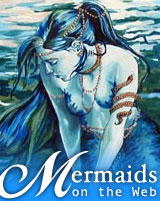
Thoughts about Mermaid Pictures
I've spent the last two weeks hunting for, sorting and looking at mermaid pictures up to twelve hours a day. This has its downside. Everyone on the street reminds me of a mermaid now, particularly if I can't see their legs. But I've learned something too, and might as well share:
Sorting images is hard. Chronology alone won't do. A complete "20th Century" section would have been enormous. Separating by media doesn't help much, so I decided on genre-categories like "pin-up" and "fantasy."
Fantasy was too large, so I decided to break that up. "Light" is for sunny airbrush jobs, unicorns and mermaid babies. "Dark" is for shadowy, threatening and twisted images. "Medium" gets what's left. "Mermaids and Mermen" is for romantic images (light-to-dark); "pin-up" is self-explanatory. That said, a large percentage of mermaids images online are, basically, "pin-ups."
The rump "20th Century" gets images that don't belong to a defined "genre." Or, if you like, they belong to the genre of high art. That doesn't mean they're good; most are dreadful. Most mermaid pictures are dreadful. Would you expect otherwise?
Everything has been done, particularly the clever ideas. I suggest the following exercise for young people who want to be an artist. Do what I did—look at thousands of mermaid pictures over a short period of time. Then sit down to draw a mermaid. If you feel depressed, don't be an artist.
The flipper-line is heading south. Like hemlines, the point at which woman becomes a fish has changed over time. While hemlines have gone up, flipper-lines have gone down. Is it a coincidence that Brazil, the nation that gave us "dental floss" bikinis, also gives us Vera Lucia, who paints mermaids with fully-defined buttocks and even knees? At the same time, the most uninhibited mermaid, the two-tailed variety common before the Victorian period, has been chased off the scene—and off the Starbucks logo. There's some deep gender-issue voodoo going on here. I feel a doctorate coming on.
The Coney Island Mermaid Parades are wild! They are also well documented. This is to be expected when you plop hundreds of scantily-clad exhibitionists—most female and young—a subway-stop away from the millions of young men with digital cameras. After looking at dozens of galleries from each year's event, I feel like I've come to know these people—zombie mermaid, sushi girl, the dude with the goatee and the orange seahorses, gold-pants, the baby in the Cambell's soup can, lobster guy. One interesting fact: although the parade's been going on for more than two decades, only the last five years are documented online. Even during the dot-com boom few pictures made it up. Cheap digital cameras have been to high-resolution body-paint naiads what the printing press was to Bibles.
Photoshop was invented to make mermaids out of regular people. I understand the urge to Photoshop things. I've certainly done it. What amazes me are the people whose hobby is to Photoshop mermaid after mermaid, piling them up by the dozen, scouring the internet for mermaid-able women. What drives this?
There is something going on between Scandinavia and mermaid statues. It's not just the Little Mermaid; there are mermaid sculptures all over the region. Is it because there are more mermaids, or is the data skewed? Do tourists take a picture with the Little Mermaid in Copenhagen and then just "get in the habit"?
How you pose with the Little Mermaid in Copenhagen is a window on your soul. Some just pose, some disrobe, some touch her, some kiss her, or worse. Interestingly, the people who sawed her head off twice, her arm once, and finally blew her from the rock with explosives didn't take pictures.
Americans are unique. I didn't stop with English-language sites. Siréne, Sirena, havfrue, denizkizi —I tried them all, and the French I explored quite deeply. Even if you imagine an aversion to mermaids where they were invented, Europeans by and large don't use the Internet to communicate about mermaids. There aren't the teenagers posting their mermaid pictures, coding up their "sirenophilia" sites, or obsessively photoshopping scores of Meerjungfrau. Again, there's some deep cultural voodoo going on here. I can't find my Tocqueville, but I'm pretty sure he noticed this too.
Got an Albanian page featuring Bulgarian mermaid statues? Email [email protected].

"Blue Mermaid" above courtesy Tania Henderson, www.henderart.com.
All material © 2000–2004 Tim Spalding. Books presented in association with Amazon.com.
If you enjoy this site you may like this other site by me:
Seahorse and Sea Dragon Central. Comprehensive guide to seahorse and sea dragons.
Angels on the Web. Images and other web resources on angels in Western culture, religion and art.
Hammerhead Shark! Hammerheads in all their glory, with a picture galery.